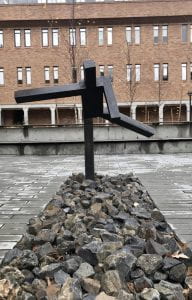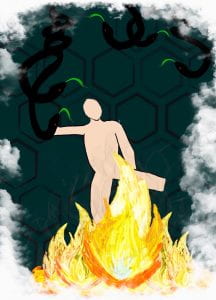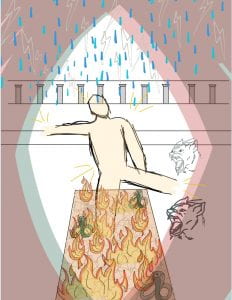Project Statement: In our interpretation of this piece we felt it depicted a person facing struggles trying to bring them down. As the audience we can’t see what exactly the struggles are (they are different for each person) but we put different common fears. We are left in a sort of suspense not knowing whether the person fell or caught themselves.They look like they could either be falling or pushing through all the struggles. The location fit this piece because we saw this piece as depicting the struggles we face and those are usually hidden. Walking past this it was easily missed.
Research:
Joel Shapiro is an American artist born on September 27th, 1941 in New York. He got his education at New York University, a BA and MA. Afterwards he joined the Peace Corps and went to India where he got a lot of inspiration. He has had more than 160 exhibitions. Joel Shapiro is known for his wooden sculptures. He brings together figures of human forms and geometric designs. He uses rectangular shapes to create a human form. He wants to describe real emotional states in his pieces. His later works have included more color and a larger size. One was a vertical figure from 1986 was almost life sized and had a white color on its torso.
The sculpture on campus by Joel shapiro is “Untitled” and upon further research, I learned that Shapiro often leaved his works untitled or creates a brief description for the piece in place of a title. An example of this is a painting of his from 1992 titled, “Untitled (Red Square with Blue)”, in which there are several black squares and then a prominent red square and blue accents. This literal approach to naming seems to be a theme of Joel Shapiro’s work. There are however several exceptions with his works which have a meaningful title such as, “SPILL”, depicting blue colors and geometric shapes“Jazz”, depicting a man playing an instrument, and “GO”, showing playful colorful circles in a painting he created for Obama.
Joel Shapiro spoke about what drove him to create many of his dynamic wooden and bronze sculptures in a 1982 interview with the Whitney Museum of American Art, “I am interested in those moments when it appears that a figure is a figure, and other moments when it looks like a bunch of wood stuck together – moments when it simultaneously configures and disfigures.” This idea is represented well in “Untitled” on our campus, the act of the figure falling or running shows the humanness to the piece and the block like nature of its limbs reminds the viewer that it is just wood stuck together.
Emma Lavine- WordPress admin., research, art piece interpretation
Linda Pacheco- Research, art piece interpretation
Chloe Young- Research
Sources:
“Joel Shapiro.” Artnet, www.artnet.com/artists/joel-shapiro/.
“Joel Shapiro – Artists – Berggruen Gallery.” Berggruen, www.berggruen.com/artists/joel-shapiro.
“Joel Shapiro (American, Born 1941) (Getty Museum).” The J. Paul Getty in Los Angeles, www.getty.edu/art/collection/artists/18428/joel-shapiro-american-born-1941/.
LeBourdais, George Philip. “How Artists of the 1980s Changed the Course of Contemporary Art.” Artsy, 17 Aug. 2015, www.artsy.net/article/artsy-editorial-the-most-iconic-artists-of-the-1980s.
Hodge, David. “‘Untitled’, Joel Shapiro, 1984” Tate, July 2015
https://www.tate.org.uk/art/artworks/shapiro-untitled-t07154



Leave a Reply